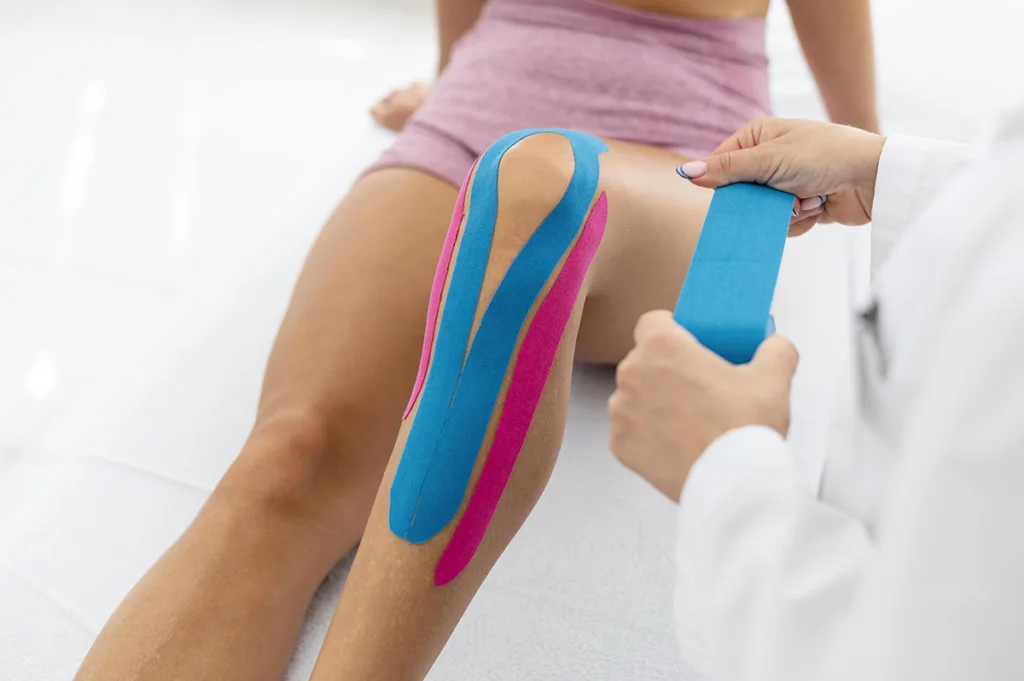Let’s be real: taping looks simple—just wrap it up and go, right? But if you’ve ever had tape fall off mid-game, irritate your skin, or do absolutely nothing for your injury, then you already know: what athletic tape is made of actually matters.
Whether you’re an athlete, trainer, or just trying to keep nagging pain in check while staying active, knowing the materials inside athletic tape can make all the difference. Because not all tape is created equal.
At TruStrength Performance and Rehab, we use athletic tape every day in rehab, performance tuning, and injury prevention. But we never just slap on whatever’s available. We choose tape based on its ingredients—because those ingredients directly affect how it sticks, supports, and protects your body.
Let’s dig into what athletic tape is really made of—and how to choose the right one for your skin, goals, and movement.
Why It Actually Matters What Athletic Tape Is Made Of
Most people don’t think twice about what’s in their tape. But here’s what we see all the time:
- Skin reactions and rashes from poor-quality adhesives
- Tape peeling off after 20 minutes of sweat
- The wrong type of tape making an injury worse instead of helping
- Athletes thinking all tape is “basically the same”
The truth? Tape composition directly affects its performance. That includes:
- How breathable it is
- How flexible or rigid it feels
- How long it stays on
- Whether it’ll irritate your skin or not
That’s why choosing the right tape isn’t just about the brand—it’s about the build.
The Main Types of Athletic Tape — and What They’re Made Of
Athletic tape generally falls into 4–5 major categories. Each has its own purpose—and its own material makeup.
1. Kinesiology Tape (K-Tape)
What it’s made of:
- Cotton or synthetic fabric base (like polyester)
- Elastic fibers (usually spandex or a synthetic blend)
- Acrylic-based adhesive
What it’s for: This is the stretchy, colorful tape you’ve seen on shoulders, knees, and backs. It’s designed to mimic the elasticity of skin and support soft tissues without restricting movement.
Why materials matter:
- Cotton is breathable and comfortable, but not super water-resistant
- Synthetic blends (like synthetic kinesiology tape) tend to be more durable and better for swimming or heavy sweating
- Acrylic adhesive is latex-free, hypoallergenic, and activated by body heat
At TruStrength, we use high-quality k-tape brands that prioritize stretch, skin safety, and long wear—because you shouldn’t have to reapply every hour.
2. Rigid Athletic Tape (Zinc Oxide Tape)
What it’s made of:
- 100% cotton or rayon backing
- Zinc oxide-infused adhesive
- Sometimes contains latex
What it’s for: If you’re taping an ankle, wrist, or finger to lock it down and restrict motion—this is your tape. No stretch, just solid support.
Why materials matter:
- Rayon provides extra strength and moisture resistance over plain cotton
- Zinc oxide adhesive is ultra-sticky (and antimicrobial), but can be harsh on sensitive skin
- Latex content can cause allergic reactions, so always check the label
Pro tip: Always use an underwrap if you’re using rigid tape on bare skin—especially for longer wear. We do this for all joint-stability taping at TruStrength.
3. Elastic Adhesive Bandage (EAB)
What it’s made of:
- Cotton-elastane blend for stretch
- Rubber-based or synthetic adhesive
What it’s for: This one’s kind of a hybrid—supportive like rigid tape, but with more give. It’s often used on larger muscle groups for compression and mobility control.
Why materials matter:
- Elastane allows for multidirectional stretch
- Rubber adhesives are grippy but can cause skin issues in people with latex or adhesive sensitivity
4. Cohesive Tape (Self-Adherent Wraps)
What it’s made of:
- Non-woven synthetic fibers
- Cohesive surface (sticks to itself, not skin)
- Latex or latex-free options
What it’s for: These wraps are great for quick fixes—like holding a bandage in place or compressing an area temporarily. No adhesive touches your skin.
Why materials matter:
- Zero adhesive = no skin irritation
- Perfect for sensitive skin, short-term taping, or layering over another wrap
5. Leukotape + Cover-Roll Combo
What it’s made of:
- Cover-Roll: soft polyester base with acrylic adhesive
- Leukotape: stiff rayon base with zinc oxide adhesive
What it’s for: We use this system for taping techniques like McConnell taping (commonly for knees or shoulders). Cover-Roll protects the skin, and Leukotape applies directional force to correct movement patterns.
Why materials matter:
- Polyester is flexible and gentle on skin
- Rayon and zinc oxide deliver the structure and support
- Acrylic adhesive reduces irritation risk
Athletic Tape Adhesives: What’s Actually Sticking to You?
Let’s zoom in on adhesives—because this is where people often run into trouble.
Common Types of Adhesives:
- Acrylic:
Latex-free, hypoallergenic, skin-safe. Found in most kinesiology tapes and medical tapes. Gentle but long-lasting. - Zinc oxide:
Sticky, durable, antimicrobial. Often used in rigid tapes. Can dry skin or cause irritation with extended use. - Rubber-based:
Strong adhesion, but common cause of skin reactions—especially in humid or sweaty environments.
The Latex Question: Should You Worry?
Here’s the deal: not all tapes are latex-free. Some rigid or elastic bandages contain natural rubber latex, which can cause serious reactions.
If you’ve had reactions to tape before—itching, burning, rashes—assume it could be the latex or the adhesive. Always check for “latex-free” labeling, and opt for acrylic-based adhesives when in doubt.
Can Athletic Tape Be Eco-Friendly?
The truth? Most tapes aren’t. They’re single-use, synthetic, and made with adhesives that don’t break down easily. That said, there are some steps in the right direction:
- Some kinesiology tapes use organic cotton or biodegradable packaging
- Brands are slowly shifting to non-toxic adhesives and less plastic
While it’s not perfect, we always choose tapes that balance function, skin safety, and impact—and we dispose of materials responsibly here at TruStrength Performance and Rehab.
How We Choose Tape at TruStrength Performance and Rehab
We don’t pick tape based on the color or brand hype. We choose it based on:
- Your skin type and sensitivity
- The type of injury or issue you’re dealing with
- What kind of movement you need—mobility or restriction
- Your performance goals
Sometimes we’ll even mix and match tape types in one session. Because taping isn’t one-size-fits-all—and neither is your recovery.
When to Book Instead of Taping It Yourself
DIY taping is great—if you know what you’re doing. But if you’re dealing with:
- Recurrent pain
- Tape that keeps peeling off
- Skin irritation
- Joint instability
- Or confusion about which tape to use…
…it’s time to let the pros handle it.
We don’t just tape. We assess. We diagnose movement dysfunctions. We guide your body toward healing and performance—and we teach you how to self-tape properly, based on your unique needs.
Final Word: What You Stick to Your Body Matters
Now you know: athletic tape isn’t just fabric and glue—it’s a tool. And what it’s made of determines how well that tool works for you.
Whether it’s cotton, spandex, rayon, acrylic, or zinc oxide—each material has its purpose. And when you get the combo right, it can mean less pain, better support, and faster recovery.
So don’t just grab the nearest roll of tape and hope for the best.
Book a Session with TruStrength — Get Taped by Pros Who Understand the Science
At TruStrength Performance and Rehab, we combine expert-level rehab knowledge with real-world athletic care. Whether you’re rehabbing an injury, trying to prevent one, or optimizing performance, our taping techniques are designed around your body’s mechanics.
Book your consultation today and let’s figure out what kind of tape—and treatment—will help you move stronger, longer, and pain-free.



